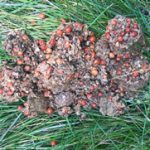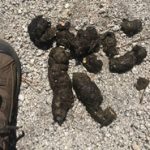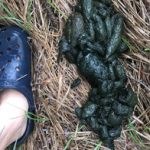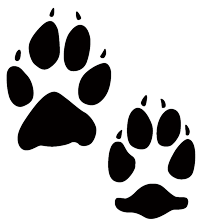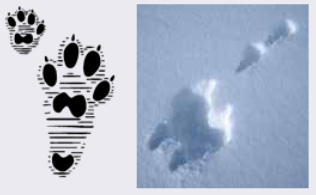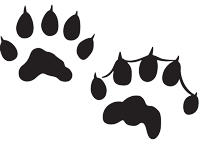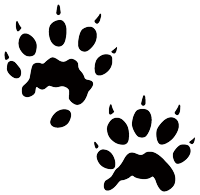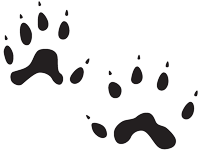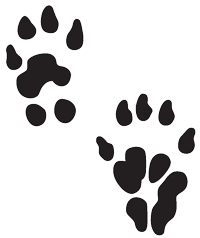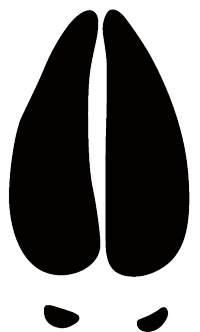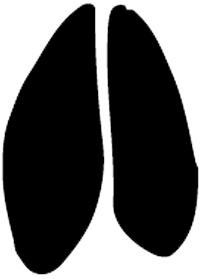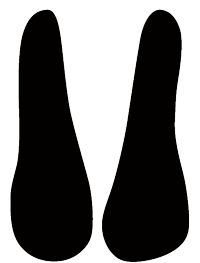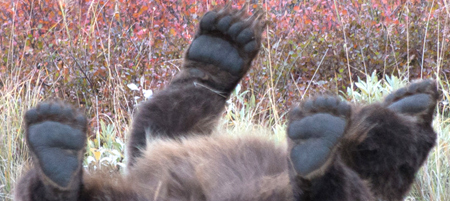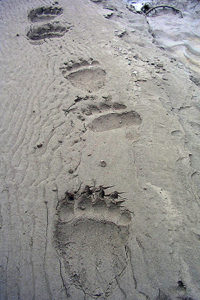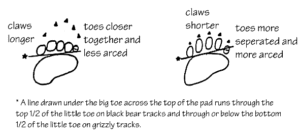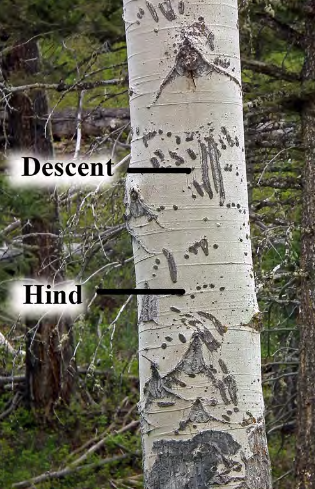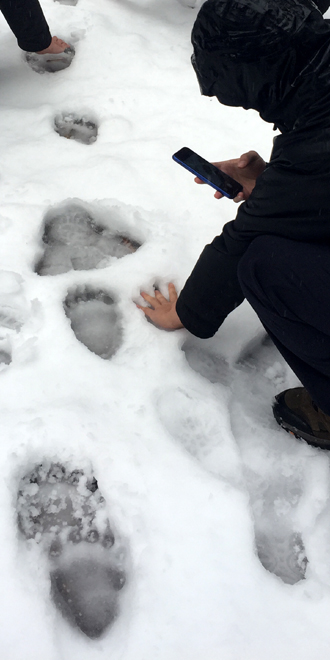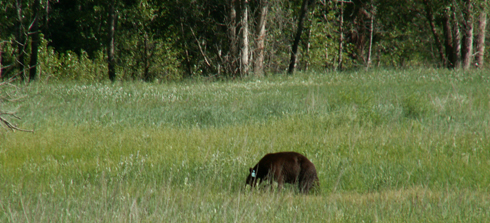photos of and notes about scat and tracks
Please do not handle scat. Wolf scat, for example, can transmit tapeworm eggs to humans. All scat has germs. Avoid breathing near the droppings, as some diseases may contracted not only by touching dust-borne particles, but also by inhaling them.
If the scat is steaming (on a cool early morning hike, for example) the animal may be VERY nearby.
bison: 
bear:  grizzly:
grizzly: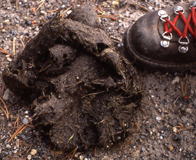
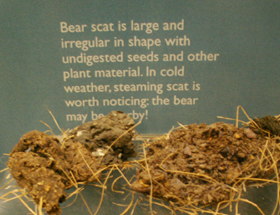
cylindical, 2′ plus (massed if vegetation main food source). We’ve most often seen bear scat that was totally very dark green and shiny.
bear scat (left hand photo is full of berries, right hand photo is glossy dark green, common when bears eat a lot of grass
Yosemite had these notes: “Here in Yosemite, you may stumble upon coyote, raccoon, mountain lion, or bobcat poop, all of which can be confused with bear poop. Coyote poop is also tubular and may contain the same foods, but it usually looks like a pile of twisted rope. Raccoons go to the bathroom in the same spot over and over, so their poops will be found in large piles called latrines. Bobcats and mountain lions both have segmented poops, a characteristic common to felines. Their poop is dense and won’t flatten if you step on it. All of the poop piles mentioned above are smaller than a bear’s.”
moose: 
chips or massed when eating aquatic plants and thick grasses, pellets (a little more oblong than elk) when eating woody browse
elk: 
chips like cattle when feeding in summer on lots of vegetation, pellets in winter when food is more dried grass
coyote: is like a dog’s but often with more hair
frequently deposited where they stop to look for prey at an open area
beaver: you won’t see this deposited on land very often
otter: short, round or flat with fish scales, bones or other aquatic food parts. Green and slimy when fresh.
(Sorry, these photos of animal scat are not printed here in a scale to show their size in relation to each other.)
The lab results of scat samples “for 2019 revealed that 35 individual mountain lions were detected in Yosemite: 14 females, 10 males, and 11 cougar samples without individual or sex identified.”
![]()
below from a Yellowstone National park Junior Ranger handbook
https://www.nps.gov/yell/learn/kidsyouth/upload/YNP_JuniorRanger_2021.pdf

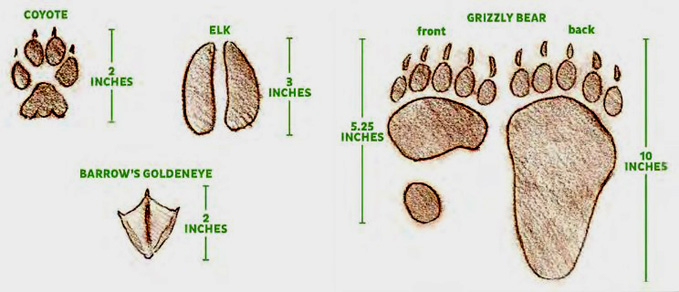
tracks (FOOT PRINTS):
Both the dog and cat family have four toes.
Bear, otter, badger, wolverine have five toes.
full coyote or wolf tracks (footprints) will almost always leave toenail imprints, a bobcat or mountain lion won’t
coyote on the left, wolf on the right:
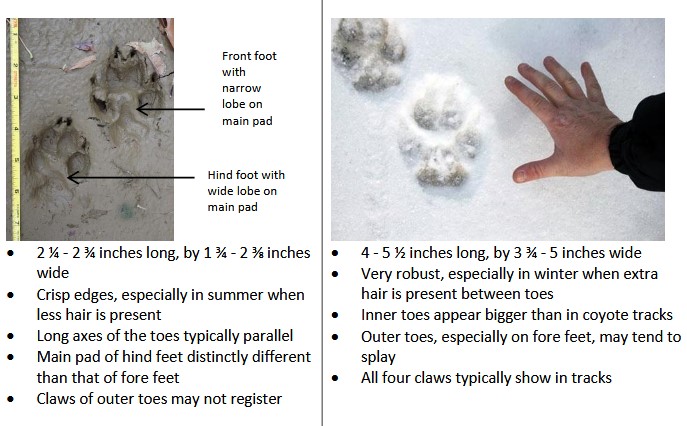
One way to tell about how big a track you see is could be to compare the size to that of your (adult) palm. Measure your palm, (an adult human might have a 3 1/2 inch by 3 1/2 palm or a 4 inch by 4 inch palm). Do not actually touch the track, leave it so others can find it, but you can hold your hand near it to estimate the size of a track. A bobcat track (footprint) “up to 2 inches wide” will fit easily within an adult’s palm, a mountain lion’s larger foot “up to 4 inches wide” will fill it or almost fill it.
another wolf track in snow: 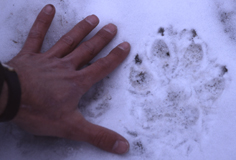
coyote has a walking stride of 6 to 8 inches and leaps of 10 feet, wolf has a walking stride of nearly 30 inches and leaps of 9 or more feet
Mountain lions scratch trees to mark their territories.
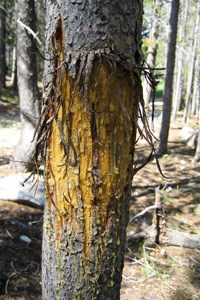
Snowshoe Hare Lepus Americanus tracks in snow:
this photo of a Marmot and a Pika sitting side by side on a trail is from Rocky Mountain mammal size comparisons.
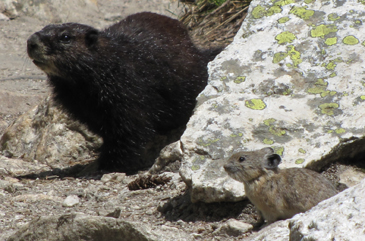
you won’t find deer or elk tracks as much in/near the water habitat of moose, and moose tracks are much larger, up to 5 to 7 inches long
moose:
pronghorn (not really an antelope but often called an antelope):
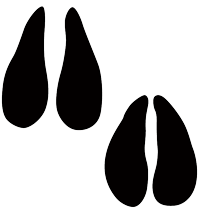
Here, human and bear tracks side by side in soft mud for a size comparison:
![]()
and for another size comparison,
griz track in snow with a dollar bill next to it
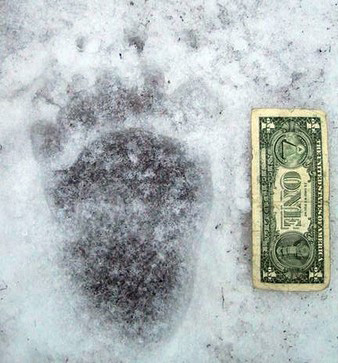
This NPS photo of a bear on it’s back shows why bear rear paw prints really do look a lot like footprints of a human:
Brown bear tracks photo from Gates of the Arctic National park:
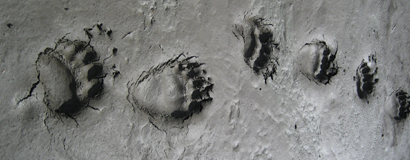
grizzly tracks have less space between toes than black bears, black bears toes arranged in more of an arc than griz, claw length (from tip of claw to front of toe) longer than toe length on griz
smallest toe of the five may fail to print
grizzly:
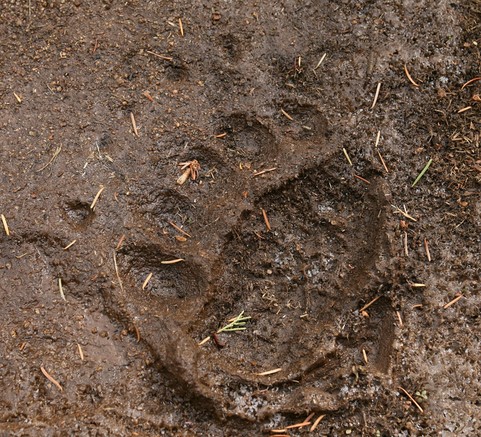
North Cascades National Park notes: Differentiating Black and Grizzly Bear Tracks
“Biologists use front tracks to distinguish bear species. You can do the same when you are out in the wilderness. Establish a line through the lowest point of the outside toe and the highest point of the palm pad. Notice that the black bear’s inside (right) toe is mostly below the line, while the grizzly bear’s is above the it. The rear foot on both species looks the same.”
The Yellowstone bear tracks chart, shown below, notes include that a line drawn from under the big toe and across the top of the pad runs through the top 1/2 of the little toe on black bear tracks and through or below the bottom 1/2 of the little toes on grizzly bear tracks.
Bears also leave signs when they scratch on trees and when they climb up and down them. This tree trunk has vertical scratch marks made by a bear during descent. The arc of five scars was made by the jab of a hind foot directly into the trunk during ascent.
and here are the size of scratch marks in relation to a human hand:
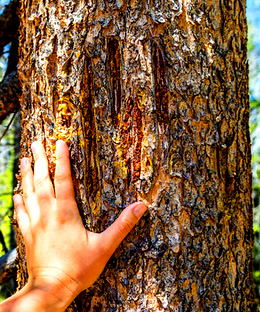
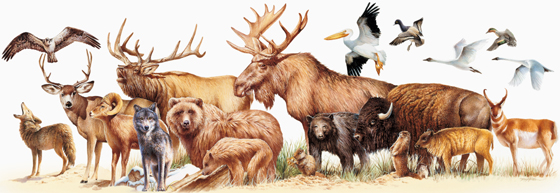 Rocky Mountain mammal size comparisons has photos and comparisons of beavers, squirrels, pika, marmot, elk, moose, bison, fox, coyote, wolf, golden-mantled ground squirrel, chipmunk, Red Squirrel (also known as) Chickaree, Unita Ground squirrels, bobcat, lynx, mountain lion (cougar), pine marten, mountain goats, bighorn sheep, pronghorn, grizzly and black bears,
Rocky Mountain mammal size comparisons has photos and comparisons of beavers, squirrels, pika, marmot, elk, moose, bison, fox, coyote, wolf, golden-mantled ground squirrel, chipmunk, Red Squirrel (also known as) Chickaree, Unita Ground squirrels, bobcat, lynx, mountain lion (cougar), pine marten, mountain goats, bighorn sheep, pronghorn, grizzly and black bears,
and the webpage includes the note that elk are not grown-up deer.

Bears sounds from the NPS:
https://www.nps.gov/subjects/bears/sounds.htm
The California Dept of Fish and Wildlife notes differences between
COYOTE (Canis latrans) and GRAY WOLF (Canis lupus) vocalizations
coyote:
Voice typically higher pitched
Howls shorter, rising and falling in pitch
Usually interspersed with yips, yaps, and barks
wolf:
Voice typically lower in pitch
Howling tends to be long and drawn-out
Can also include growls and barks
Well worth looking at:
https://www.nps.gov/yell/learn/resources-and-issues.htm

For actual incidents of injuries from animals, usually caused by approaching them too closely, go to: fatal, near fatal or close call incidents/accidents in camping, backpacking, climbing and mountaineering
Look for the BEARS, MOUNTAIN LION, BISON, ELK and MOOSE sections.

For your safety while wildlife viewing, stay 25 yards away, at least, for most wildlife, and 100 yards for bears, moose, elk, bison and wolves, whether on foot or in your car.
Keep the animal’s line of travel or escape route clear and move away if wildlife approaches you.
How far away is 100 yards? Picture the length of a football field without the end zones.
25 yards? picture four car lengths or six kayak lengths, or the width of an Olympic-sized pool like ours at the college.
If you have an accidental, surprise or inadvertent closer encounter with wildlife you must remove yourself to those distances, including while driving on a road.
Safe Distances from Wildlife includes reasons to stay away from even friendly seeming animals in parks, and charts and photos to better be able to determine and visualize how far away from wildlife you need to stay to be safe (and obey laws that do have penalties).
wildlife jams has some safety info and etiquette.
Grand Canyon National Park rangers say: “Follow the rule of thumb: if you can cover the entire wild animal with your thumb you’re at a safe distance. This distance is usually 25 yards from most wildlife and 100 yards from large wildlife . . . If you are close enough to take a selfie with an animal, you are too close. ”
Parks Canada warns, along with keeping a proper distance from animals :
“If you spot the following defensive warning signals, pull back even more or leave the area:
Bears make a ‘woofing’ noise, growl and snap their jaws;
Bull elk and moose put their heads down and paw at the ground;
Cow elk flatten their ears, stare directly at you and raise their rump hair.
If you cause an animal to move, you are too close.”
and a telephoto lens for your camera.
A report from Grand Teton National Park listed what they found in grizzly bear scat:
“A recent synthesis of the available literature on grizzly bear diets (Gunther et al. 2014) determined that the most frequently detected items in 11,478 scats collected during 37 years between 1943 to 2009 were graminoids [grasses], 58.7%; ants, 15.8%; whitebark pine seeds, 15.4%; clover, 11.19%; and dandelion, 10.9%. Other items frequently detected were elk, 8.3%; thistle, 6.9%; horsetail, 5.6%; yampa roots, 4.9%; berries, 4.9%; cutthroat trout, 4.4%; biscuit root, 4.0%; spring beauty, 2.9%; bison, 2.8%; and fireweed, 2.7%. The review also noted the annual stability of the most frequently detected diet‐items during 33 years between 1943 and 2009. The most stable items were graminoids, ants, and elk, which were found in the collected scats in all years (100% of years); clover was present during 97% of years; and elk, thistle and horsetail were found in 94% of years.”
Read more at: bears
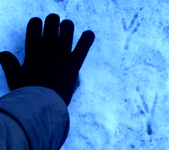
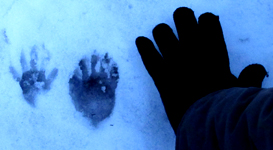
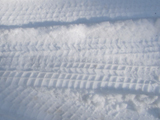
On the 2019 Yosemite winter trip we compared our paws to the tracks of a bear in the snow, in which we could clearly see claw tracks. (Black bears in Yosemite are not true hibernators. Some sleep on and off, some years some bears never go into hibernation.)
Yellowstone Grizzly Bears: Ecology and Conservation of an Icon of Wildness
” . . . Bears can see in color, can hear in the ultrasonic range, and possess an incredible sense of smell.. . Heaviest Known Body Mass in the Greater Yellowstone Ecosystem: Adult male 715 pounds (324 kilograms); Adult female 436 pounds (198 kilograms)
Speed: 35 to 40 miles per hour (56 to 64 kilometers per hour)
Strength: 2.5 to 5 times greater than humans
. . . 1944: Olaus Murie . . . experimented with electric cattle prods to teach bears to avoid campgrounds, but concluded “the bear learns to recognize the particular person or car that administers the shock or other punishment, and simply avoids that person or car in the future, but does not fear other persons or cars.”
$39.95 or a free download https://www.nps.gov/yell/learn/nature/upload/Yellowstone_Grizzlies_Web.pdf

The Yosemite National Park rangers would like you to call them
if you see a bear in Yosemite,
no matter where it is or what it is doing.
Since 2003 there has been a note in the Yosemite Guide Newspaper: “REPORT ALL BEAR SIGHTINGS! To report bear sightings, improper food storage, trash problems, and other bear-related problems, leave a message for the Bear Management team at: 1 (209) 372-0322. Your call can be made anonymously.”

If you can, in all the excitement, try to notice if the bear has a tag (usually on the ear), the color of the tag and if possible, the number on it (the tag is large enough that with a telephoto lens you should be able to read the number).
From the Yosemite Daily Report newspaper:
“It is extremely important to remember to yell at bears that are in and around development, even if they are foraging on natural food. Though it is very tempting to get close for a picture, or just to watch these incredible animals, it is important not to give into this urge. Yelling at them if they are in residential areas or near people is critical to keep bears natural fear of humans. Giving bears plenty of space. When bears become too comfortable around people, they will often start causing damage to structures and vehicles, or will even become too bold around people, creating safety concerns.”
And the Yosemite Daily Report also said:
“Scare bears when you see them. . . in developed areas- Yell like you mean it!
Make as much noise as possible, try waving your arms, stomping your feet
or anything to make you look intimidating and to get the bear to run away.
We know it’s fun to see bears and it can feel mean to scare them,
but this is a simple way to truly help save a bear’s life.”


 </
</